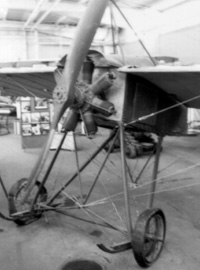Conservation - Borel-Morane

A Borel-Morane at the Exposition internationale de la
locomotion aérienne at the Grand Palais, in Paris circa 1912
You can follow the conservation process in the on-line diary.
The Canada Aviation Museum recently acquired a Borel-Morane monoplane from aviation’s pioneer era. It is the oldest surviving aircraft to have flown in Canada. Built in France by the Société anonyme des aéroplanes Morane-Borel-Saulnier, it bears a resemblance to the popular Type XI monoplanes that Louis Blériot sold after his famous flight across the English Channel in 1909. The monoplane was brought to North America by Georges Mestach for flight exhibition.
Mestach, a Belgian who learned to fly in France, found fleeting fame for his flight demonstrations on this side of the Atlantic. The small fraternity of early exhibition pilots attracted large crowds eager to witness the wonders of flight. Winnipeg, Québec and Sherbrooke were among the Canadian cities visited by Mestach during the summer of 1912.

Borel-Morane's first
owner: George Mestach
Aviators of this era often suffered mishaps in their frail and unstable machines. Mestach was no exception to the rule and at Winnipeg his machine proved no match for the stiff prairie wind. Badly damaged in a crash against a fence, it was shipped back to his operating base at Chicago for repairs. Later in 1912, it collided with a Wright biplane at the Chicago Air Meet, resulting in North America’s first midair collision fatality when the Wright pilot lost his life.
An issue concerning import duty irregularities resulted in the sale of the damaged monoplane to William Sommerville of Illinois, but Mestach continued to fly the machine for its new owner for a period of time before returning to Europe. Mestach eventually lost his life in the 1920s while trying to establish an airline service in the Belgian Congo.

Borel-Morane's third
owner: Earl Daugherty
Another pilot working for Sommerville, Earl S. Daugherty, then bought the machine in 1914 and raced it in the Long Beach area of California. Daugherty, another of aviation’s early exhibition pilots, later established a company that often engaged in stunt work for early Hollywood aviation films. Although he later lost his life in an aerial accident during the late 1920s, his family kept the little monoplane until the Museum acquired it in 2002.
Time has not been kind to the little monoplane that also lost its engine a number of years ago. However, because it has never been restored, the airframe still retains all of its original components including its original wing fabric. It is the Museum’s intention to conserve the aircraft in its present condition so that its originality is preserved.
The Borel-Morane monoplane was first inspected in June 2002 by conservation staff prior to acquisition, and was subsequently acquired by the Canada Aviation Museum (CAvM). The aircraft was crated and transported from Exeter, California to the Museum in September 2002.

Cockpit detail
When the dismantled aircraft arrived at the Museum it was immediately placed inside a fumigation bubble, within the conservation area. This was necessary as a possible insect infestation was suspected during the preliminary inspection of the wings and fuselage. The aircraft was fumigated, in a controlled environment with carbon dioxide gas, before being introduced into the Museum collection.
It is the Museum’s responsibility to preserve and safeguard acquired objects for future study and exhibition. Part of this conservation process is the documentation of the object’s current physical condition. The object is also photographed, with detailed images of damaged areas.

The Borel-Morane in the late 1970s
The Borel-Morane monoplane was previously stored inside a warehouse, partially dismantled and uncovered. The aircraft’s overall general condition is structurally sound with characteristic shrinkage in wooden wings, airframes and landing skids. The Borel-Morane unfortunately has no engine, some engine compartment components are missing and it was acquired with a broken propeller blade.
Treatment of the Borel-Morane began in March 2003 with a estimated completion date of late fall 2004. Our conservative estimated time required for this conservation treatment is 500 hours. Missing components will have to be researched and, when possible, acquired for addition to the aircraft. The final assembly can only be accomplished when frail and deteriorated materials have been treated and stabilized. Stay tuned for future treatment information.

